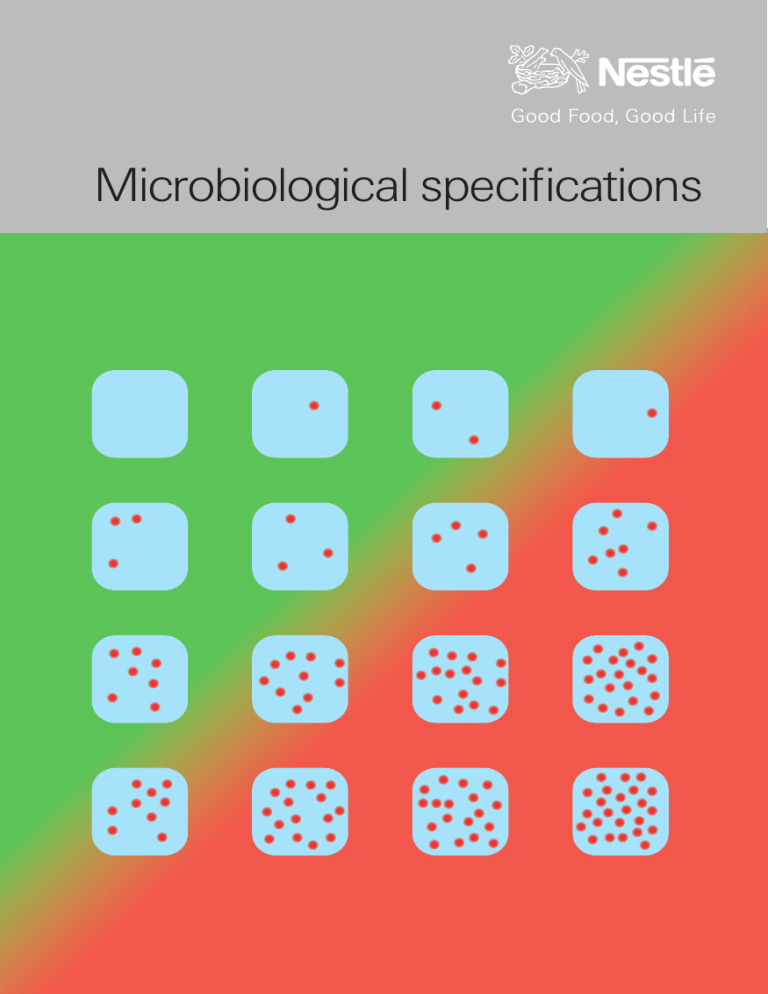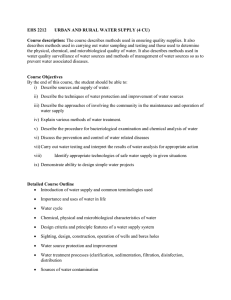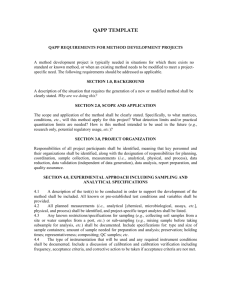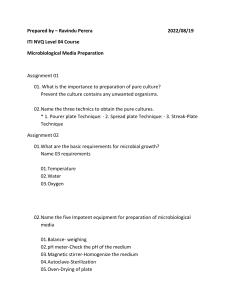
Microbiological specifications Table of contents 2 2 Purpose of this booklet Food Safety: Managing microbiological risks 3 4 4 5 The definition of microbiological criteria Why do we use microbiological criteria/specifications Three types of microbiological criteria: Codex Alimentarius Assessing adherence to microbiological specifications 6 Considerations for establishing microbiological specifications 8 9 10 13 Components of microbiological specifications Microorganisms – Pathogens Microorganisms – Hygiene indicators Microorganisms – Others 14 16 17 Sampling plans The stringency of microbiological specifications Sampling plans – Two- and three-class plans 18 Analytical Microbiological Methods 19 Frequently asked questions 1 Purpose of this booklet: To help you understand Food Safety: Managing microbiological risks • Why we use microbiological criteria/ specifications for raw materials (RM), food ingredients, finished-products (FP) at various stages of the food chain. • What are the main components of microbiological specifications. • How Nestlé establishes microbiological specifications for raw materials. The safety of foodstuffs is neither guaranteed nor controlled by microbiological testing. The safety of foodstuffs is primarily ensured by a preventative approach, such as implementation of Good Hygiene Practice (GHP) and application of procedures based on Hazard Analysis and Critical Control Point (HACCP) principles. The management of the microbiological risks at each stage of manufacturing process must be considered i.e. from farm to fork. This includes the quality of RM to reflect Good Agricultural Practices (GAP) and Good Manufacturing Practices (GMP). 2 The Food Production Chain The definition of microbiological criteria Microbiological criteria are used at any stage in the food chain to assess the acceptance of lots of raw material or finished product. They are based on the absence / presence of certain microorganisms or quantitative limits of these or other microorganisms, per unit(s) of mass, volume, area or lot. Production Processing Distribution Retail Consumption 3 Why do we use microbiological criteria/ specifications Three types of microbiological criteria: Codex Alimentarius A large volume of food is exchanged worldwide between countries and shipped from sellers to buyers. End product testing alone cannot ensure safe foods, due to sampling plan limitations. Therefore, foods are not systematically tested. Microbiological Standards Mandatory microbiological criteria which are written into law or government regulations and specified by government to protect public health, e.g. European Hygiene and Food Safety Criteria 2073/2005. Buyers, consumers or governments rely on the suppliers’ food safety management systems to assure safe food throughout the food supply chain. To harmonise food safety and ensure trading alignment, metrics such as microbiological criteria have been established. Microbiological Guidelines Microbiological criteria which provide advice to food manufacturers about acceptable or expected microbial levels when the food production process is under control when applying best practices. Microbiological Specifications Microbiological criteria established between buyers and producers that define product quality and safety attributes required by the buyer. The scope of this booklet is limited to microbiological specifications, describing the approach taken by Nestlé to establish and prescribe specifications to suppliers. 4 Assessing adherence to microbiological specifications Analytical Microbiological Methods are used to assess if RM or FP are in agreement with the microbiological specifications. Microbiological testing may be used by industry or government. Lot testing, against the pre-defined specifications, is the most commonly used method. Further information on use of microbiological methods is available on p.18. Defining a Lot: For Nestlé microbiological specifications, a lot corresponds to a specified quantity of product manufactured, filled and packaged under the same conditions, thereby expected to have reasonably uniform quality characteristics. It should never represent more than one day filling/production. Frequency of Testing: Supplies of RM from suppliers are not systematically analysed, but must comply with microbiological specifications. Testing is a verification of the effectiveness of food safety management systems, including prerequisite programmes and control measures in place at suppliers. The frequency of analyses by the supplier is dictated by their confidence in their prerequisite programmes and control measures. A supplier approval process and audit of suppliers will be used to assess the prerequisite programmes in place, with appropriate test verification. Facility Environmental Monitoring Suppliers of RM should have in place an adequate environmental monitoring programme (EMP). An effective EMP in a food processing facility is an important component of any food safety management system. It can act as an early warning system for microbiological hazards in both the production and surrounding environment. It helps to identify harbourage niches and ‘hot spots’ that may act as a source of contamination and verify overall sanitary design, hygiene, personal practices and operational methods in the facility. Target microorganisms in an environmental monitoring plan should include indicator microorganisms, pathogens and/or spoilage organisms. Such a plan defines zones to monitor, ranging from high risk to low risk (for product contamination). 5 Considerations for establishing microbiological specifications Microbiological specifications for RM are derived from those established for the corresponding FP. These already take account of the products’ Ready to Eat (RTE) /Non Ready to Eat (NRTE) status. The FP microbiological specification must also consider the consumer group for which the FP is destined (e.g. infants versus adults). At the outset, it should be considered if there is a need to establish a microbiological specification for a RM. When it is deemed necessary, the definition and limits of the microbiological specifications must consider the usage of the RM i.e. the application or not of a microbial kill step. If a kill step is to be applied then the nature of this microbial kill step will influence the RM microbiological specifications: Influences on the stringency of raw material microbiological specifications 1. Is a microbiological specification required? In some circumstances, e.g. syntheticallymanufactured ingredients, microbiological specifications are not required. 2. Where a microbiological specification is required, the usage of the RM must be considered. If the RM is to be used without any further microbial kill step, stringent microbiological requirements will apply. However, if a kill step is applied to RM before inclusion in the finished product, less stringent microbiological specifications will apply. 3. The nature of the microbial kill step applied impacts RM microbiological specifications For example, the application of pasteurisation compared to Ultra High Temperature (UHT) will impact the microbial parameters and stringency requirements of RM used for the different processing methods. Stringency of RM microbiological specifications 6 Raw Material (RM) No Yes For example flavours (without carrier matrix) No further Kill Step Application of Kill Step For example Pasteurisation For example UHT Infant Formula Ice Cream Ready-to-drink product High Medium Low 7 Components of microbiological specifications Sampling Plans Stringency Limits Microrganisms Pathogens Hygiene indicators Others 8 Analytical Microbiological Methods Microorganisms – Pathogens A considerable number of foodborne pathogens exist. FP microbiological criteria / RM specifications include a limited number of these as microbiological parameters. Factors influencing the selection of microbiological components of specifications are: • Is the pathogen known to be linked with this specific RM or food product? Is this link well established? • Have similar RM or food products been involved in foodborne outbreaks? • Is the pathogen likely to be found in the processing environment? • Is pathogen applicable/included in FP microbiological specifications thus dictating inclusion in RM microbiological specifications? Factors influencing the selection of microbiological components of specifications Foodborne pathogens include those which cause gastrointestinal illness after ingestion and invasion/ colonisation of host tissues, for example, Salmonella, Listeria monocytogenes, Shiga toxin-producing Escherichia coli (STEC). A number of pathogenic bacteria e.g. Bacillus cereus, Staphylococus aureus and Clostridium perfringens cause illness through intoxication. Their toxins can be preformed in food when bacterial numbers increase to high levels (>105 cfu/g). Salmonella, Listeria monocytogenes and Cronobacter sakazakii are generally the only pathogens stipulated in RM specifications by Nestlé. While Salmonella will be included in the majority of specifications, the inclusion of L. monocytogenes and C. sakazakii will be dependant on FP for which the RM is to be used and type of process. 9 Microorganisms – Hygiene indicators Hygiene indicators are frequently included in microbiological specifications and are widely accepted within the scientific and regulatory community. Their purpose are: • To help in the verification of GMP/ GHP and HACCP. • To indicate deviations in hygiene or sanitary conditions – Unacceptable levels will indicate an increased risk of the presence of associated pathogens. • Many hygiene indicators described in scientific literature have overlapping characteristics and therefore can be considered redundant or beyond requirements. • Enterobacteriaceae (Eb) and aerobic mesophilic count (AMC) are the hygiene indicators of choice for Nestlé RM microbiological specifications. The applicability and suitability of AMC and Eb are illustrated below. • Food processors may include alternate hygiene indicators in microbiological specifications. Nevertheless, while acceptable, these are only included if deemed necessary in Nestlé RM microbiological specifications for the reasons given. Internationally recognised hygiene indicators applied in Nestlé microbiological specifications Hygiene indicator Description Where applicable Comment Aerobic Mesophilic Count (AMC) Refers to the total load of viable mesophilic, aerobic microorganisms. Often applied to verify the application of processing steps such as heat treatment. It can also be used as an indicator for adherence to GMP/GHP. Also referred to as Aerobic Colony Count (ACC), Standard Plate Count (SPC) and Aerobic Plate Count (APC). Enterobacteriaceae A large group of bacteria, with similar properties, including species originating from the intestinal tract of animals and humans as well as plants and the environment. The interrelationship between Eb and other frequently used hygiene indicators is illustrated. As they are killed by heat processes used in food production and are readily removed from factory equipment and environment by appropriate cleaning, their presence is indicative of post process (re) contamination in heat processed material. One of the most frequently applied hygiene indicator. Now commonly applied as process hygiene criteria in EU regulations and thus in many cases replaces previous coliform criteria. 10 The relationship between Salmonella, pathogenic E. coli (E. coli O157/STEC) and the commonly used Enterobacteriaceae hygiene indicator, and related hygiene indicators Enterobacteriaceae Total coliforms E. coli E. coli 0157 STEC Faecal coliforms Salmonella 11 Internationally recognised hygiene indicators not generally applied in raw material specifications by Nestlé Hygiene indicator Description Where applicable Comment Coliforms A functional subgroup of Eb’s but may also contain organisms outside the Eb group. As for Eb group. Coliforms are a poorly defined group and there is variability between detection methods thus they are being systematically replaced by Eb (see previously). Faecal coliforms/ E.coli A functional subgroup of Eb, most commonly used as an indicator of faecal contamination. While low levels of faecal coliforms and E. coli may be present on raw foods (produce, meat nuts seafood), high levels are indicative of substantial faecal contamination. Faecal coliforms and E. coli should not be present in highly processed ready to eat foods. They tend to die off quickly in dry foods and therefore are not considered useful for dry products. Listeria spp. May provide a good indication of the likelihood of contamination with L. monocytogenes. Generally applied to wet plant environments and equipment (e.g. chilled and frozen). Their presence can indicate hygiene status of process environment. Can be present and persist in drains/ water-containing environments – may indicate inadequacies in sanitation. 12 Microorganisms – Others Four categories of bacterial spores are commonly included in Nestlé RM microbiological specifications. The application of these and the set limits (m) depend on the nature of the FP. The 4 combinations of bacterial spore-formers used in raw material microbiological specifications by Nestlé Spore Parameters (in Microbiological Specifications) Where and When applied Aerobic mesophilic spores Can be included where it is deemed necessary that the subsequent thermal process applied to RM may be insufficient to destroy spores and therefore could impact final product AMC. Spores of Bacillus spp. is the common target microorganism. Anaerobic mesophilic spores May be used as a hygiene indicator in RM at risk of Clostridial spore contamination, e.g. C. botulinum. Sulphite reducing Clostridia (SRC) are often specified for similar reasons. Aerobic thermophilic spores May be included to specify quality of RM, where those RM are used to manufacture low-acid commercially sterile products (e.g. retorted/UHT) and thus will help minimize insterility rates. Anaerobic thermophilic spores May be occasionally used where subsequent quality defects can be attributed to thermophilic Clostridia spp. Thermo-resistant molds may survive thermal processing and therefore may be included in specifications to avoid the risk of spoilage in high-acid products. aureus and/or Bacillus cereus in RM microbiological specifications. Stringent FP specifications with respect to these bacteria will drive their inclusion in RM specifications. Exceptionally, Nestlé may include coagulase positive Staphylococcus 13 Sampling plans The sampling plan summarises the requirements (limits) and defines their stringency. It is the basis for the decision on release / acceptance of tested lots. Sampling plans are expressed by 3 or 4 parameters and are defined as two- or three-class plans respectively. Every sampling plan has a certain amount of risk by which a good lot is rejected or a bad lot is accepted, due to microbiological testing limitation and the heterogeneous distribution of microorganisms in the sample. Parameters defining sampling plans: n = number of samples or units analyzed. c = maximum allowable number of sample units yielding marginal results, i.e. results between m and M. m = microbiological level that separates good quality from defective, or in a three-class plan good from marginally acceptable quality. M = microbiological level in a threeclass plan that separates marginally acceptable from unacceptable (defective) quality. Note: In a two-class plan M is assimilated to m. The analytical unit is included in the sampling plan. Nestlé uses two-class plans for microbiological specifications of RM’s, therefore n, c and m are defined. 14 Infant Formula Parameter n c m M Analytical unit Pathogen(s) Salmonella C. sakazakii 60 30 0 0 0 0 25g 10g Hygiene indicators Aerobic mesophilic counts Enterobacteriaceae 5 10 0 0 500 0 1g 10g Pathogen(s) Salmonella 10 0 0 25g Hygiene indicators Aerobic mesophilic counts Enterobacteriaceae 5 5 0 0 10 4 10 1g 1g Confectionery An illustrative example of different stringencies applied to microbiological specifications. RM – sucrose used for infant formula (no further kill step) and used for confectionery (used as wet mix; further microbial kill step applied). 15 The stringency of microbiological specifications The choice of n and c varies with the desired stringency. This stringency is guided by the level of risk associated with the RM/FP and how the material is to be used/processed/consumed. compromise between what is an ideal probability of acceptance and the work load the laboratory can handle as sampling plans should be administratively and economically feasible. For high stringency n is high and c is low. Choice of n is usually a n c High stringency Low stringency Interrelationship between n and c for microbiological specification stringency 16 Sampling plans – Two- and three-class plans A concentration (m) may also be assigned in a two-class plan, e.g. 1000 cfu/g, above which the sample is considered unacceptable. There are two widely accepted types of sampling plans as defined by the International Commission for Microbiological Specifications for Food (ICMSF): Three-class plans are frequently used to examine for hygiene indicator where enumeration of microbes in a unitvolume or mass is possible. Such plans can be used to separate the quality of a lot into acceptable, marginally acceptable and unacceptable. Two-class plans are used essentially for pathogens and where a presence/ absence test is to be performed (e.g. presence/absence of Salmonella). In the case of a presence /absence analysis, c = 0 and m = 0. The presence of the target microorganism is unacceptable. Two-class plan m Acceptable Unacceptable The microbiological limit (m) separates the quality of a lot between acceptable and unacceptable in a two-class plan Three-class plan m Acceptable M Marginal Unacceptable The microbiological limits (m and M) separate the quality of a lot between acceptable, marginally acceptable and unacceptable in a three-class plan 17 Analytical Microbiological Methods For each of the microorganisms or group of microorganisms included in the microbiological specifications, at least one analytical method should be available. Ideally, the analytical method used should be readily available and easily applied on a routine basis. They should be based on international standards (e.g. ISO methods). Alternate methods should be validated against such standard methods. If pooling (of samples) is considered as a means of reducing the number of analytical units, evidence must be available to confirm equivalent performance of a pooling strategy. Foodstuff Sample analytics Diagnostics 18 Frequently asked questions Do all microbiological parameters have to be analysed for each batch? No, the supplier must have the necessary control measures and prerequisite programmes in place with their corresponding analytical verification as deemed necessary (monitoring). A vendor approval system and audit will assess compliance. An increased frequency of testing (’positive release’) may be required if non compliance is demonstrated. Is the probability of detecting pathogens the same if we reduce the number of analytical units and propotionally increase the sample size (e.g. equivalence of 3 x 500g; 60 x 25g; 1500 x 1g)? No, drawing greater numbers of smaller samples provides greater protection than drawing the same total weight of sample in fewer sample units. There is an increased chance of detecting contamination due to uneven distribution of contamination. A calculation table is available from ICMSF (www.icmsf.org) which can determine equivalence. However, the feasibility of analysing larger volumes must be considered and suppliers are encouraged to seek advice from Nestlé experts. Is analytical pooling possible for Salmonella or Eb and what are the limits? Why have we have stated 375g for S, 100g for Eb? Yes, pooling is acceptable up to 375g for Salmonella and up to 100g for Eb. Pooling up to these analytical volumes have been validated. The 100g pooling limit for Eb was established based on the fact that for many microbiological specifications n = 10, hence 10 x 10g samples could be pooled, compared to 15 x 25g for Salmonella. What is meant by wet mix, dry mix, MR2, EB10 and MR1? Wet mix ingredients are those where a further kill step will be applied to them before finished product is produced. Dry mix ingredients will be used without any microbial kill step before finished product production. Dry and wet do not necessarily mean powder and liquid ingredients respectively. Microbiological Requirement Level 2 (MR2) is defined as the absence of Eb in 1g samples and Salmonella in 25g samples. EB10 is defined as the absence of Eb in 10g samples and the absence of Salmonella in 25g samples. Microbiological Requirement Level 1 (MR1) is defined as the absence of Eb in 10g samples, absence of Cronobacter sakazakii in 10g and Salmonella in 25g samples. 19 Why/when does Nestlé use two-class or three-class plans for ingredients? In most circumstances Nestlé prescribe only two-class plans for RM microbiological specifications. Regardless of the stipulation of a twoor three-class plan, in practice, m is always the target. The two-class plan represents a more straightforward approach to manage RM microbiological specifications. Is the purchasing microbiological specification a “to-do-list” or a guarantee? Central to the role of microbiological specifications are the concepts of probability and sampling. The sampling plan has a certain amount of risk by which a good lot is rejected or a bad lot is accepted therefore it indicates a probability of acceptance. The provision of a Certificate of Compliance (CoC) by suppliers shall serve as a guarantee that ingredients comply with raw material purchasing microbiological specifications. 20 Which microorganisms should be monitored in ingredient production environment(s)? The supplier may choose to monitor microorganisms deemed suitable for the environment in which ingredients are manufactured. This can include nominated pathogens e.g. Salmonella (‘dry‘ environment), Listeria monocytogenes (‘wet’ environment) and/or suitable hygiene indicators e.g. Eb or Listeria spp. © 2014, Nestec Ltd., Vevey (Switzerland) Concept Nestec Ltd., CO – Quality Management, Vevey (Switzerland) Design Nestec Ltd., Corporate Identity & Design with Christian Stuker (Switzerland) Production brain’print GmbH (Switzerland)



